Reflective Account: Induction Process, Teamwork, and Placement Skills
VerifiedAdded on 2020/01/16
|10
|3247
|206
Report
AI Summary
This report provides a reflective account of a student's experience with the induction process, teamwork, and skills development during a placement. It begins with the student's opinion of the induction process, emphasizing its role in familiarizing new employees with the company and its environment. The report then identifies the skills applicable to the tasks, such as communication, problem-solving, and commitment. It also discusses the skills developed during the placement, including data analysis and IT proficiency. The second part of the report focuses on teamwork, its importance in organizations, and the dynamics within teams, including the challenges and successes encountered. The report also references Tuckman's model of team development and Belbin's team roles. Finally, it addresses the successes and difficulties encountered during the placement and production phases, such as building trust and managing conflicts. The report concludes by summarizing the key takeaways from the experience.

REFLECTIVE ACCOUNT
Paraphrase This Document
Need a fresh take? Get an instant paraphrase of this document with our AI Paraphraser
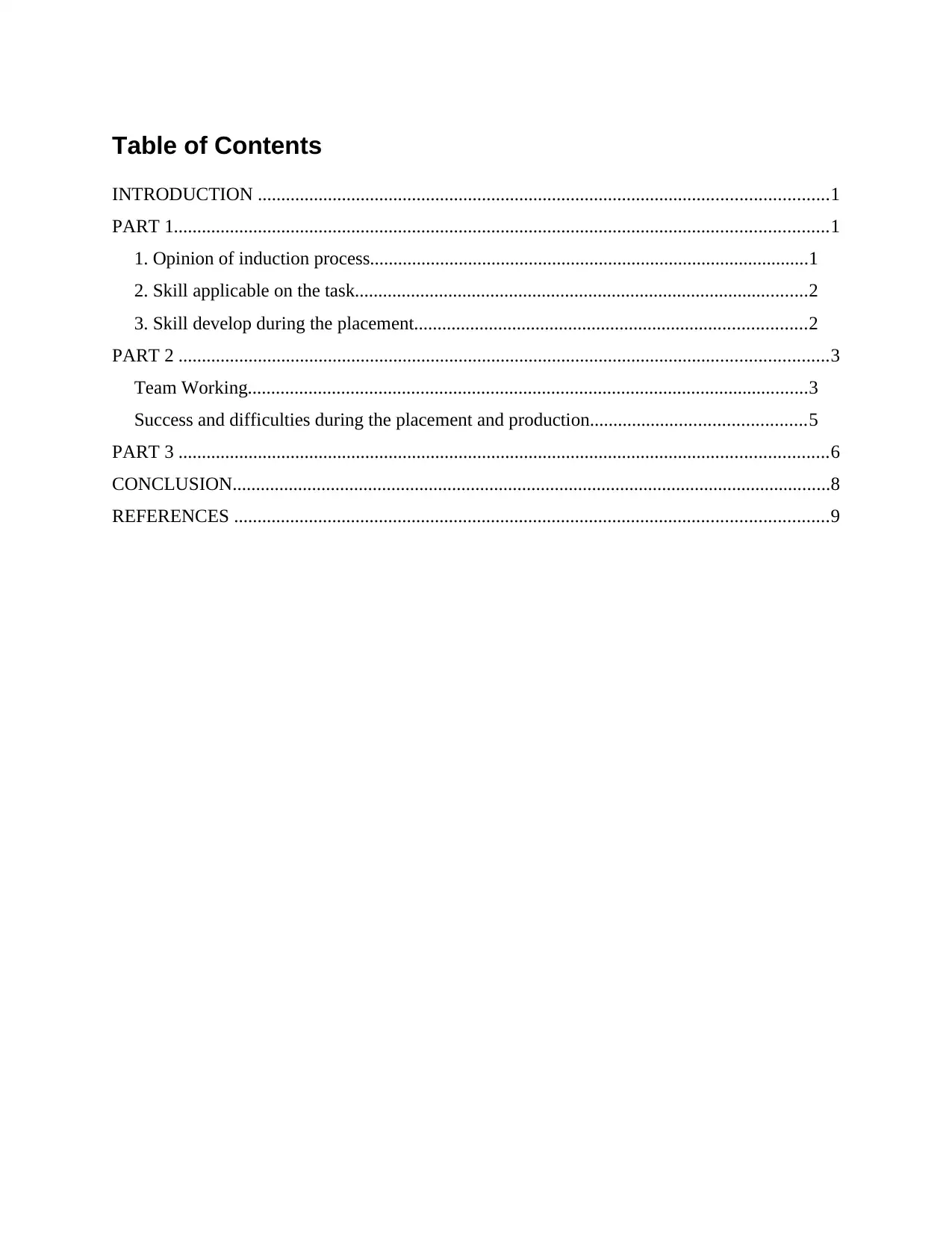
Table of Contents
INTRODUCTION ..........................................................................................................................1
PART 1............................................................................................................................................1
1. Opinion of induction process..............................................................................................1
2. Skill applicable on the task.................................................................................................2
3. Skill develop during the placement....................................................................................2
PART 2 ...........................................................................................................................................3
Team Working........................................................................................................................3
Success and difficulties during the placement and production..............................................5
PART 3 ...........................................................................................................................................6
CONCLUSION................................................................................................................................8
REFERENCES ...............................................................................................................................9
INTRODUCTION ..........................................................................................................................1
PART 1............................................................................................................................................1
1. Opinion of induction process..............................................................................................1
2. Skill applicable on the task.................................................................................................2
3. Skill develop during the placement....................................................................................2
PART 2 ...........................................................................................................................................3
Team Working........................................................................................................................3
Success and difficulties during the placement and production..............................................5
PART 3 ...........................................................................................................................................6
CONCLUSION................................................................................................................................8
REFERENCES ...............................................................................................................................9
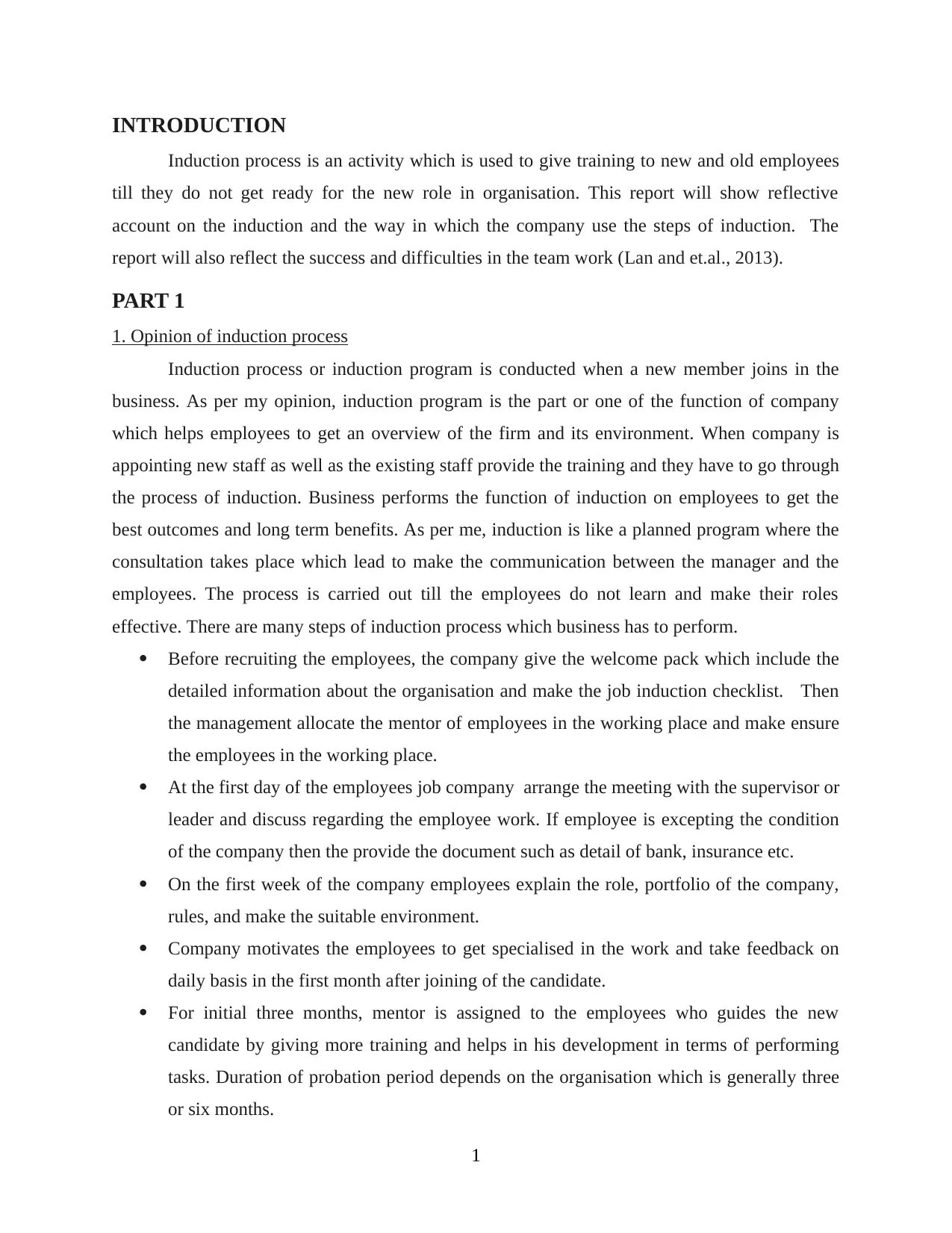
INTRODUCTION
Induction process is an activity which is used to give training to new and old employees
till they do not get ready for the new role in organisation. This report will show reflective
account on the induction and the way in which the company use the steps of induction. The
report will also reflect the success and difficulties in the team work (Lan and et.al., 2013).
PART 1
1. Opinion of induction process
Induction process or induction program is conducted when a new member joins in the
business. As per my opinion, induction program is the part or one of the function of company
which helps employees to get an overview of the firm and its environment. When company is
appointing new staff as well as the existing staff provide the training and they have to go through
the process of induction. Business performs the function of induction on employees to get the
best outcomes and long term benefits. As per me, induction is like a planned program where the
consultation takes place which lead to make the communication between the manager and the
employees. The process is carried out till the employees do not learn and make their roles
effective. There are many steps of induction process which business has to perform.
Before recruiting the employees, the company give the welcome pack which include the
detailed information about the organisation and make the job induction checklist. Then
the management allocate the mentor of employees in the working place and make ensure
the employees in the working place.
At the first day of the employees job company arrange the meeting with the supervisor or
leader and discuss regarding the employee work. If employee is excepting the condition
of the company then the provide the document such as detail of bank, insurance etc.
On the first week of the company employees explain the role, portfolio of the company,
rules, and make the suitable environment.
Company motivates the employees to get specialised in the work and take feedback on
daily basis in the first month after joining of the candidate.
For initial three months, mentor is assigned to the employees who guides the new
candidate by giving more training and helps in his development in terms of performing
tasks. Duration of probation period depends on the organisation which is generally three
or six months.
1
Induction process is an activity which is used to give training to new and old employees
till they do not get ready for the new role in organisation. This report will show reflective
account on the induction and the way in which the company use the steps of induction. The
report will also reflect the success and difficulties in the team work (Lan and et.al., 2013).
PART 1
1. Opinion of induction process
Induction process or induction program is conducted when a new member joins in the
business. As per my opinion, induction program is the part or one of the function of company
which helps employees to get an overview of the firm and its environment. When company is
appointing new staff as well as the existing staff provide the training and they have to go through
the process of induction. Business performs the function of induction on employees to get the
best outcomes and long term benefits. As per me, induction is like a planned program where the
consultation takes place which lead to make the communication between the manager and the
employees. The process is carried out till the employees do not learn and make their roles
effective. There are many steps of induction process which business has to perform.
Before recruiting the employees, the company give the welcome pack which include the
detailed information about the organisation and make the job induction checklist. Then
the management allocate the mentor of employees in the working place and make ensure
the employees in the working place.
At the first day of the employees job company arrange the meeting with the supervisor or
leader and discuss regarding the employee work. If employee is excepting the condition
of the company then the provide the document such as detail of bank, insurance etc.
On the first week of the company employees explain the role, portfolio of the company,
rules, and make the suitable environment.
Company motivates the employees to get specialised in the work and take feedback on
daily basis in the first month after joining of the candidate.
For initial three months, mentor is assigned to the employees who guides the new
candidate by giving more training and helps in his development in terms of performing
tasks. Duration of probation period depends on the organisation which is generally three
or six months.
1
⊘ This is a preview!⊘
Do you want full access?
Subscribe today to unlock all pages.

Trusted by 1+ million students worldwide
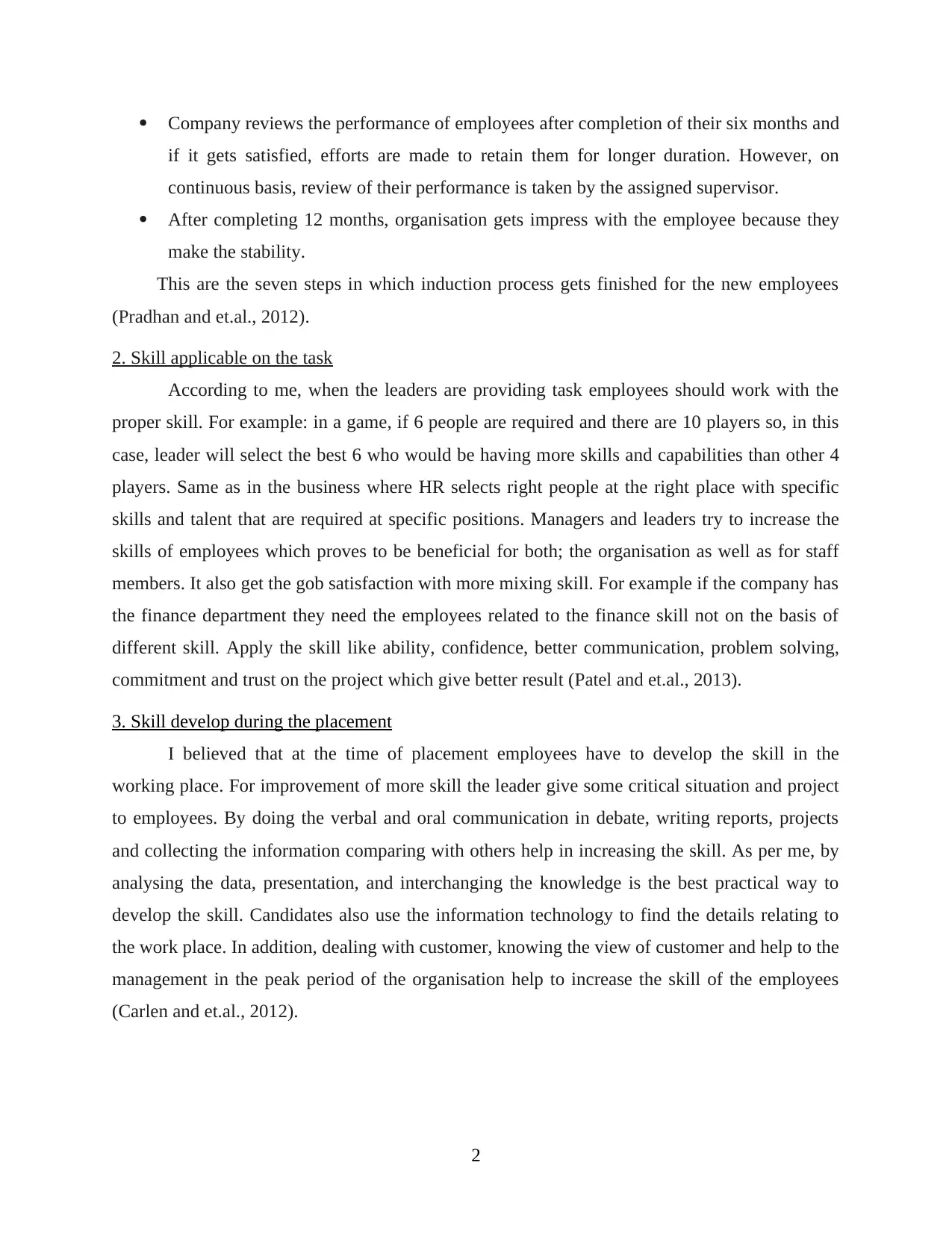
Company reviews the performance of employees after completion of their six months and
if it gets satisfied, efforts are made to retain them for longer duration. However, on
continuous basis, review of their performance is taken by the assigned supervisor.
After completing 12 months, organisation gets impress with the employee because they
make the stability.
This are the seven steps in which induction process gets finished for the new employees
(Pradhan and et.al., 2012).
2. Skill applicable on the task
According to me, when the leaders are providing task employees should work with the
proper skill. For example: in a game, if 6 people are required and there are 10 players so, in this
case, leader will select the best 6 who would be having more skills and capabilities than other 4
players. Same as in the business where HR selects right people at the right place with specific
skills and talent that are required at specific positions. Managers and leaders try to increase the
skills of employees which proves to be beneficial for both; the organisation as well as for staff
members. It also get the gob satisfaction with more mixing skill. For example if the company has
the finance department they need the employees related to the finance skill not on the basis of
different skill. Apply the skill like ability, confidence, better communication, problem solving,
commitment and trust on the project which give better result (Patel and et.al., 2013).
3. Skill develop during the placement
I believed that at the time of placement employees have to develop the skill in the
working place. For improvement of more skill the leader give some critical situation and project
to employees. By doing the verbal and oral communication in debate, writing reports, projects
and collecting the information comparing with others help in increasing the skill. As per me, by
analysing the data, presentation, and interchanging the knowledge is the best practical way to
develop the skill. Candidates also use the information technology to find the details relating to
the work place. In addition, dealing with customer, knowing the view of customer and help to the
management in the peak period of the organisation help to increase the skill of the employees
(Carlen and et.al., 2012).
2
if it gets satisfied, efforts are made to retain them for longer duration. However, on
continuous basis, review of their performance is taken by the assigned supervisor.
After completing 12 months, organisation gets impress with the employee because they
make the stability.
This are the seven steps in which induction process gets finished for the new employees
(Pradhan and et.al., 2012).
2. Skill applicable on the task
According to me, when the leaders are providing task employees should work with the
proper skill. For example: in a game, if 6 people are required and there are 10 players so, in this
case, leader will select the best 6 who would be having more skills and capabilities than other 4
players. Same as in the business where HR selects right people at the right place with specific
skills and talent that are required at specific positions. Managers and leaders try to increase the
skills of employees which proves to be beneficial for both; the organisation as well as for staff
members. It also get the gob satisfaction with more mixing skill. For example if the company has
the finance department they need the employees related to the finance skill not on the basis of
different skill. Apply the skill like ability, confidence, better communication, problem solving,
commitment and trust on the project which give better result (Patel and et.al., 2013).
3. Skill develop during the placement
I believed that at the time of placement employees have to develop the skill in the
working place. For improvement of more skill the leader give some critical situation and project
to employees. By doing the verbal and oral communication in debate, writing reports, projects
and collecting the information comparing with others help in increasing the skill. As per me, by
analysing the data, presentation, and interchanging the knowledge is the best practical way to
develop the skill. Candidates also use the information technology to find the details relating to
the work place. In addition, dealing with customer, knowing the view of customer and help to the
management in the peak period of the organisation help to increase the skill of the employees
(Carlen and et.al., 2012).
2
Paraphrase This Document
Need a fresh take? Get an instant paraphrase of this document with our AI Paraphraser
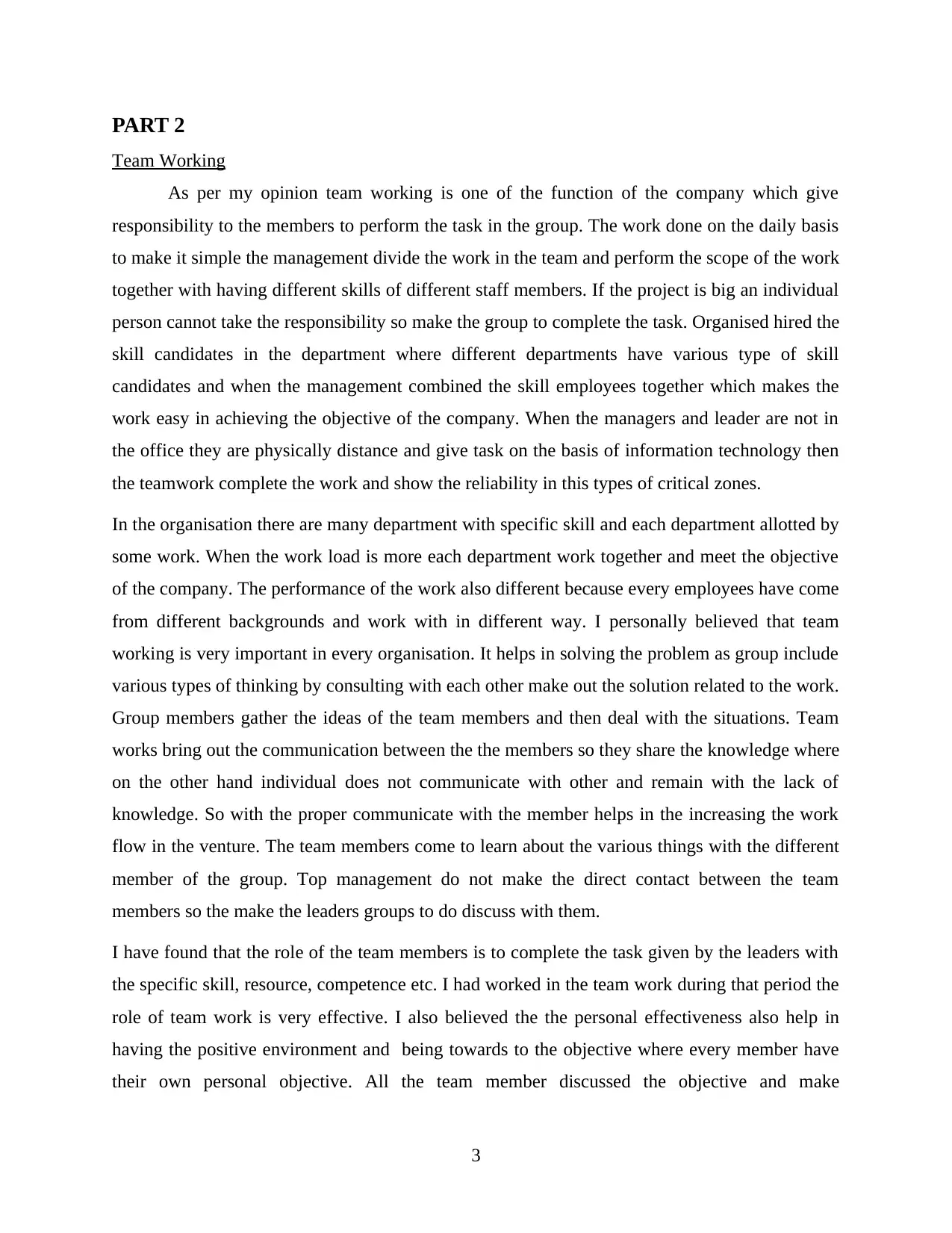
PART 2
Team Working
As per my opinion team working is one of the function of the company which give
responsibility to the members to perform the task in the group. The work done on the daily basis
to make it simple the management divide the work in the team and perform the scope of the work
together with having different skills of different staff members. If the project is big an individual
person cannot take the responsibility so make the group to complete the task. Organised hired the
skill candidates in the department where different departments have various type of skill
candidates and when the management combined the skill employees together which makes the
work easy in achieving the objective of the company. When the managers and leader are not in
the office they are physically distance and give task on the basis of information technology then
the teamwork complete the work and show the reliability in this types of critical zones.
In the organisation there are many department with specific skill and each department allotted by
some work. When the work load is more each department work together and meet the objective
of the company. The performance of the work also different because every employees have come
from different backgrounds and work with in different way. I personally believed that team
working is very important in every organisation. It helps in solving the problem as group include
various types of thinking by consulting with each other make out the solution related to the work.
Group members gather the ideas of the team members and then deal with the situations. Team
works bring out the communication between the the members so they share the knowledge where
on the other hand individual does not communicate with other and remain with the lack of
knowledge. So with the proper communicate with the member helps in the increasing the work
flow in the venture. The team members come to learn about the various things with the different
member of the group. Top management do not make the direct contact between the team
members so the make the leaders groups to do discuss with them.
I have found that the role of the team members is to complete the task given by the leaders with
the specific skill, resource, competence etc. I had worked in the team work during that period the
role of team work is very effective. I also believed the the personal effectiveness also help in
having the positive environment and being towards to the objective where every member have
their own personal objective. All the team member discussed the objective and make
3
Team Working
As per my opinion team working is one of the function of the company which give
responsibility to the members to perform the task in the group. The work done on the daily basis
to make it simple the management divide the work in the team and perform the scope of the work
together with having different skills of different staff members. If the project is big an individual
person cannot take the responsibility so make the group to complete the task. Organised hired the
skill candidates in the department where different departments have various type of skill
candidates and when the management combined the skill employees together which makes the
work easy in achieving the objective of the company. When the managers and leader are not in
the office they are physically distance and give task on the basis of information technology then
the teamwork complete the work and show the reliability in this types of critical zones.
In the organisation there are many department with specific skill and each department allotted by
some work. When the work load is more each department work together and meet the objective
of the company. The performance of the work also different because every employees have come
from different backgrounds and work with in different way. I personally believed that team
working is very important in every organisation. It helps in solving the problem as group include
various types of thinking by consulting with each other make out the solution related to the work.
Group members gather the ideas of the team members and then deal with the situations. Team
works bring out the communication between the the members so they share the knowledge where
on the other hand individual does not communicate with other and remain with the lack of
knowledge. So with the proper communicate with the member helps in the increasing the work
flow in the venture. The team members come to learn about the various things with the different
member of the group. Top management do not make the direct contact between the team
members so the make the leaders groups to do discuss with them.
I have found that the role of the team members is to complete the task given by the leaders with
the specific skill, resource, competence etc. I had worked in the team work during that period the
role of team work is very effective. I also believed the the personal effectiveness also help in
having the positive environment and being towards to the objective where every member have
their own personal objective. All the team member discussed the objective and make
3
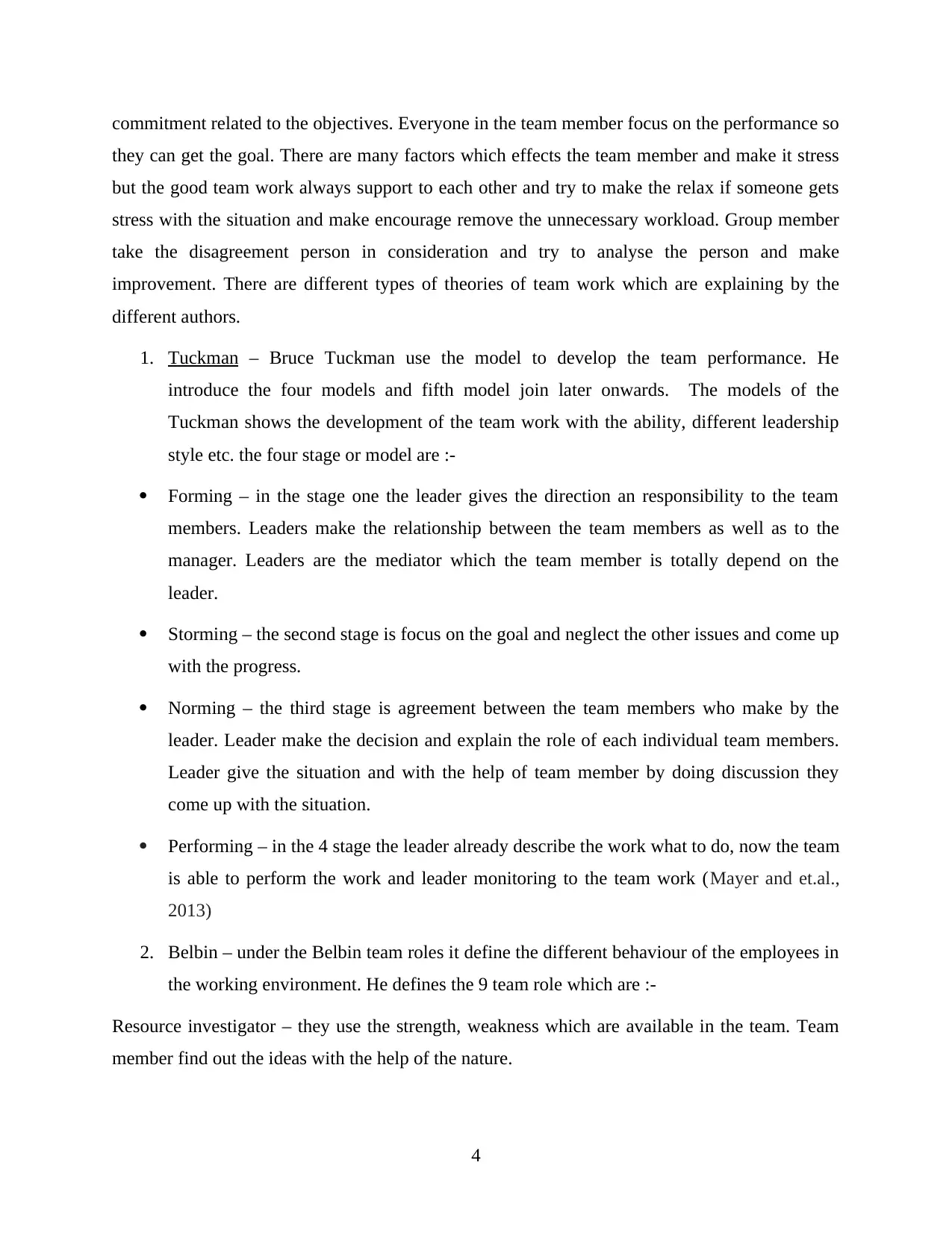
commitment related to the objectives. Everyone in the team member focus on the performance so
they can get the goal. There are many factors which effects the team member and make it stress
but the good team work always support to each other and try to make the relax if someone gets
stress with the situation and make encourage remove the unnecessary workload. Group member
take the disagreement person in consideration and try to analyse the person and make
improvement. There are different types of theories of team work which are explaining by the
different authors.
1. Tuckman – Bruce Tuckman use the model to develop the team performance. He
introduce the four models and fifth model join later onwards. The models of the
Tuckman shows the development of the team work with the ability, different leadership
style etc. the four stage or model are :-
Forming – in the stage one the leader gives the direction an responsibility to the team
members. Leaders make the relationship between the team members as well as to the
manager. Leaders are the mediator which the team member is totally depend on the
leader.
Storming – the second stage is focus on the goal and neglect the other issues and come up
with the progress.
Norming – the third stage is agreement between the team members who make by the
leader. Leader make the decision and explain the role of each individual team members.
Leader give the situation and with the help of team member by doing discussion they
come up with the situation.
Performing – in the 4 stage the leader already describe the work what to do, now the team
is able to perform the work and leader monitoring to the team work (Mayer and et.al.,
2013)
2. Belbin – under the Belbin team roles it define the different behaviour of the employees in
the working environment. He defines the 9 team role which are :-
Resource investigator – they use the strength, weakness which are available in the team. Team
member find out the ideas with the help of the nature.
4
they can get the goal. There are many factors which effects the team member and make it stress
but the good team work always support to each other and try to make the relax if someone gets
stress with the situation and make encourage remove the unnecessary workload. Group member
take the disagreement person in consideration and try to analyse the person and make
improvement. There are different types of theories of team work which are explaining by the
different authors.
1. Tuckman – Bruce Tuckman use the model to develop the team performance. He
introduce the four models and fifth model join later onwards. The models of the
Tuckman shows the development of the team work with the ability, different leadership
style etc. the four stage or model are :-
Forming – in the stage one the leader gives the direction an responsibility to the team
members. Leaders make the relationship between the team members as well as to the
manager. Leaders are the mediator which the team member is totally depend on the
leader.
Storming – the second stage is focus on the goal and neglect the other issues and come up
with the progress.
Norming – the third stage is agreement between the team members who make by the
leader. Leader make the decision and explain the role of each individual team members.
Leader give the situation and with the help of team member by doing discussion they
come up with the situation.
Performing – in the 4 stage the leader already describe the work what to do, now the team
is able to perform the work and leader monitoring to the team work (Mayer and et.al.,
2013)
2. Belbin – under the Belbin team roles it define the different behaviour of the employees in
the working environment. He defines the 9 team role which are :-
Resource investigator – they use the strength, weakness which are available in the team. Team
member find out the ideas with the help of the nature.
4
⊘ This is a preview!⊘
Do you want full access?
Subscribe today to unlock all pages.

Trusted by 1+ million students worldwide
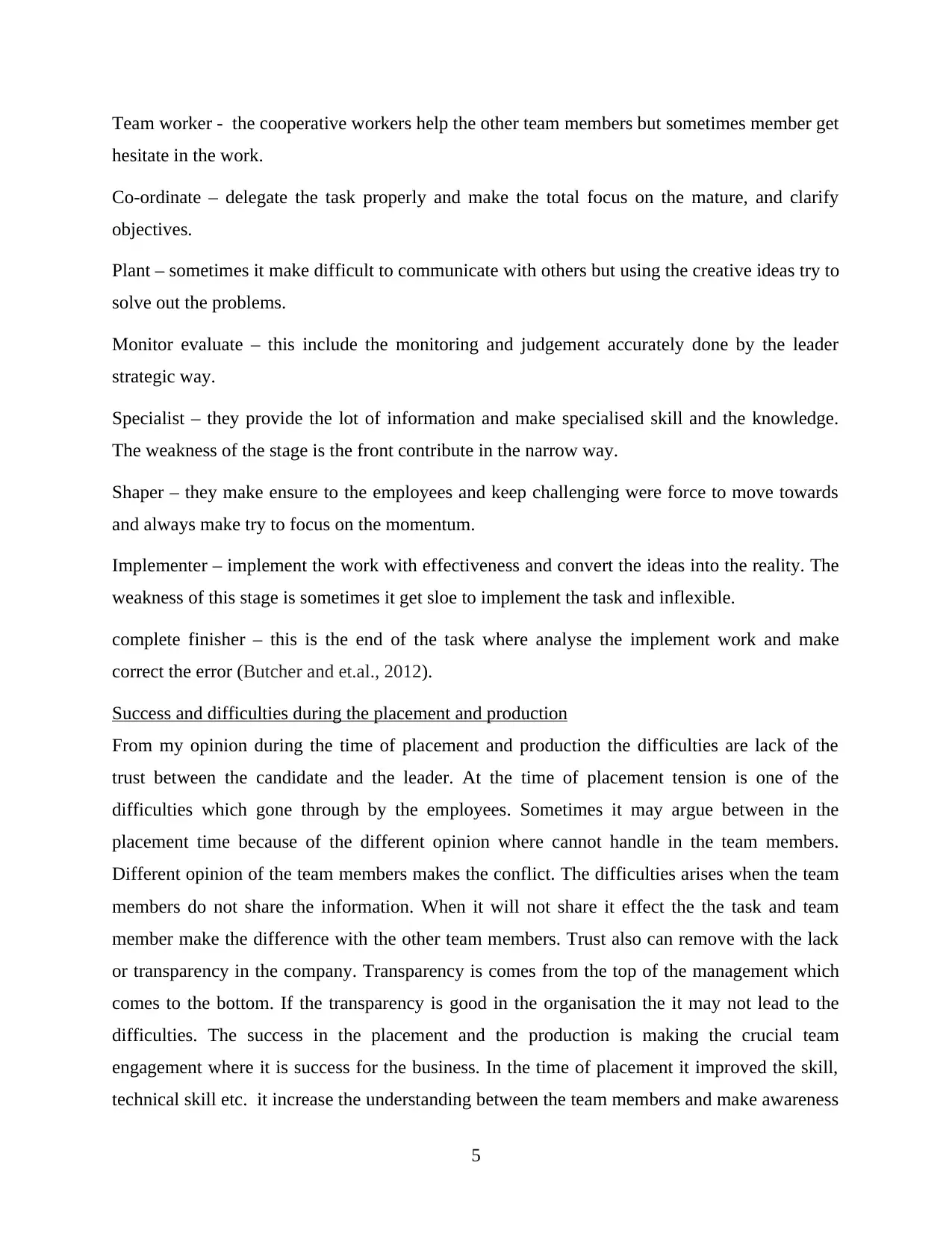
Team worker - the cooperative workers help the other team members but sometimes member get
hesitate in the work.
Co-ordinate – delegate the task properly and make the total focus on the mature, and clarify
objectives.
Plant – sometimes it make difficult to communicate with others but using the creative ideas try to
solve out the problems.
Monitor evaluate – this include the monitoring and judgement accurately done by the leader
strategic way.
Specialist – they provide the lot of information and make specialised skill and the knowledge.
The weakness of the stage is the front contribute in the narrow way.
Shaper – they make ensure to the employees and keep challenging were force to move towards
and always make try to focus on the momentum.
Implementer – implement the work with effectiveness and convert the ideas into the reality. The
weakness of this stage is sometimes it get sloe to implement the task and inflexible.
complete finisher – this is the end of the task where analyse the implement work and make
correct the error (Butcher and et.al., 2012).
Success and difficulties during the placement and production
From my opinion during the time of placement and production the difficulties are lack of the
trust between the candidate and the leader. At the time of placement tension is one of the
difficulties which gone through by the employees. Sometimes it may argue between in the
placement time because of the different opinion where cannot handle in the team members.
Different opinion of the team members makes the conflict. The difficulties arises when the team
members do not share the information. When it will not share it effect the the task and team
member make the difference with the other team members. Trust also can remove with the lack
or transparency in the company. Transparency is comes from the top of the management which
comes to the bottom. If the transparency is good in the organisation the it may not lead to the
difficulties. The success in the placement and the production is making the crucial team
engagement where it is success for the business. In the time of placement it improved the skill,
technical skill etc. it increase the understanding between the team members and make awareness
5
hesitate in the work.
Co-ordinate – delegate the task properly and make the total focus on the mature, and clarify
objectives.
Plant – sometimes it make difficult to communicate with others but using the creative ideas try to
solve out the problems.
Monitor evaluate – this include the monitoring and judgement accurately done by the leader
strategic way.
Specialist – they provide the lot of information and make specialised skill and the knowledge.
The weakness of the stage is the front contribute in the narrow way.
Shaper – they make ensure to the employees and keep challenging were force to move towards
and always make try to focus on the momentum.
Implementer – implement the work with effectiveness and convert the ideas into the reality. The
weakness of this stage is sometimes it get sloe to implement the task and inflexible.
complete finisher – this is the end of the task where analyse the implement work and make
correct the error (Butcher and et.al., 2012).
Success and difficulties during the placement and production
From my opinion during the time of placement and production the difficulties are lack of the
trust between the candidate and the leader. At the time of placement tension is one of the
difficulties which gone through by the employees. Sometimes it may argue between in the
placement time because of the different opinion where cannot handle in the team members.
Different opinion of the team members makes the conflict. The difficulties arises when the team
members do not share the information. When it will not share it effect the the task and team
member make the difference with the other team members. Trust also can remove with the lack
or transparency in the company. Transparency is comes from the top of the management which
comes to the bottom. If the transparency is good in the organisation the it may not lead to the
difficulties. The success in the placement and the production is making the crucial team
engagement where it is success for the business. In the time of placement it improved the skill,
technical skill etc. it increase the understanding between the team members and make awareness
5
Paraphrase This Document
Need a fresh take? Get an instant paraphrase of this document with our AI Paraphraser
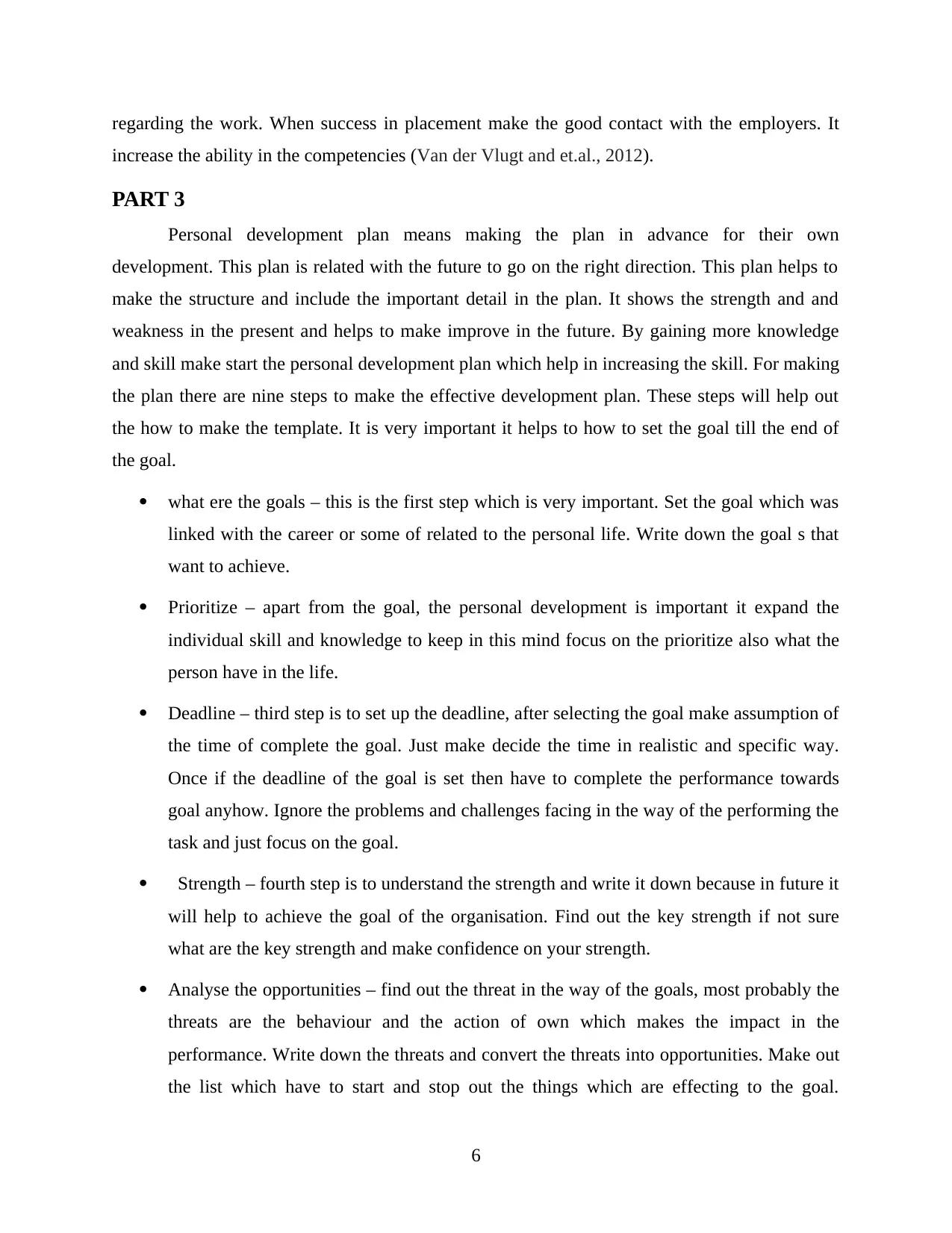
regarding the work. When success in placement make the good contact with the employers. It
increase the ability in the competencies (Van der Vlugt and et.al., 2012).
PART 3
Personal development plan means making the plan in advance for their own
development. This plan is related with the future to go on the right direction. This plan helps to
make the structure and include the important detail in the plan. It shows the strength and and
weakness in the present and helps to make improve in the future. By gaining more knowledge
and skill make start the personal development plan which help in increasing the skill. For making
the plan there are nine steps to make the effective development plan. These steps will help out
the how to make the template. It is very important it helps to how to set the goal till the end of
the goal.
what ere the goals – this is the first step which is very important. Set the goal which was
linked with the career or some of related to the personal life. Write down the goal s that
want to achieve.
Prioritize – apart from the goal, the personal development is important it expand the
individual skill and knowledge to keep in this mind focus on the prioritize also what the
person have in the life.
Deadline – third step is to set up the deadline, after selecting the goal make assumption of
the time of complete the goal. Just make decide the time in realistic and specific way.
Once if the deadline of the goal is set then have to complete the performance towards
goal anyhow. Ignore the problems and challenges facing in the way of the performing the
task and just focus on the goal.
Strength – fourth step is to understand the strength and write it down because in future it
will help to achieve the goal of the organisation. Find out the key strength if not sure
what are the key strength and make confidence on your strength.
Analyse the opportunities – find out the threat in the way of the goals, most probably the
threats are the behaviour and the action of own which makes the impact in the
performance. Write down the threats and convert the threats into opportunities. Make out
the list which have to start and stop out the things which are effecting to the goal.
6
increase the ability in the competencies (Van der Vlugt and et.al., 2012).
PART 3
Personal development plan means making the plan in advance for their own
development. This plan is related with the future to go on the right direction. This plan helps to
make the structure and include the important detail in the plan. It shows the strength and and
weakness in the present and helps to make improve in the future. By gaining more knowledge
and skill make start the personal development plan which help in increasing the skill. For making
the plan there are nine steps to make the effective development plan. These steps will help out
the how to make the template. It is very important it helps to how to set the goal till the end of
the goal.
what ere the goals – this is the first step which is very important. Set the goal which was
linked with the career or some of related to the personal life. Write down the goal s that
want to achieve.
Prioritize – apart from the goal, the personal development is important it expand the
individual skill and knowledge to keep in this mind focus on the prioritize also what the
person have in the life.
Deadline – third step is to set up the deadline, after selecting the goal make assumption of
the time of complete the goal. Just make decide the time in realistic and specific way.
Once if the deadline of the goal is set then have to complete the performance towards
goal anyhow. Ignore the problems and challenges facing in the way of the performing the
task and just focus on the goal.
Strength – fourth step is to understand the strength and write it down because in future it
will help to achieve the goal of the organisation. Find out the key strength if not sure
what are the key strength and make confidence on your strength.
Analyse the opportunities – find out the threat in the way of the goals, most probably the
threats are the behaviour and the action of own which makes the impact in the
performance. Write down the threats and convert the threats into opportunities. Make out
the list which have to start and stop out the things which are effecting to the goal.
6
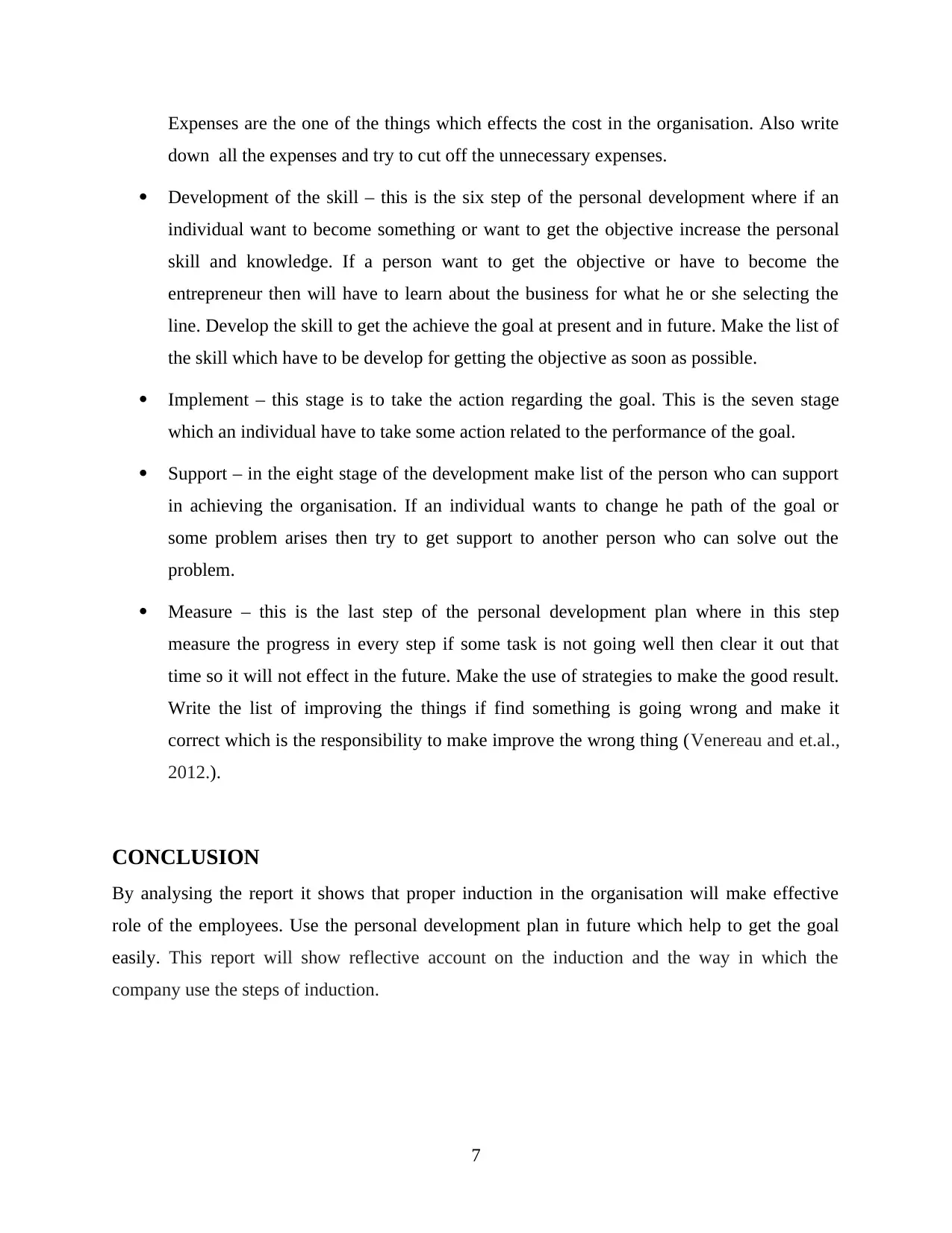
Expenses are the one of the things which effects the cost in the organisation. Also write
down all the expenses and try to cut off the unnecessary expenses.
Development of the skill – this is the six step of the personal development where if an
individual want to become something or want to get the objective increase the personal
skill and knowledge. If a person want to get the objective or have to become the
entrepreneur then will have to learn about the business for what he or she selecting the
line. Develop the skill to get the achieve the goal at present and in future. Make the list of
the skill which have to be develop for getting the objective as soon as possible.
Implement – this stage is to take the action regarding the goal. This is the seven stage
which an individual have to take some action related to the performance of the goal.
Support – in the eight stage of the development make list of the person who can support
in achieving the organisation. If an individual wants to change he path of the goal or
some problem arises then try to get support to another person who can solve out the
problem.
Measure – this is the last step of the personal development plan where in this step
measure the progress in every step if some task is not going well then clear it out that
time so it will not effect in the future. Make the use of strategies to make the good result.
Write the list of improving the things if find something is going wrong and make it
correct which is the responsibility to make improve the wrong thing (Venereau and et.al.,
2012.).
CONCLUSION
By analysing the report it shows that proper induction in the organisation will make effective
role of the employees. Use the personal development plan in future which help to get the goal
easily. This report will show reflective account on the induction and the way in which the
company use the steps of induction.
7
down all the expenses and try to cut off the unnecessary expenses.
Development of the skill – this is the six step of the personal development where if an
individual want to become something or want to get the objective increase the personal
skill and knowledge. If a person want to get the objective or have to become the
entrepreneur then will have to learn about the business for what he or she selecting the
line. Develop the skill to get the achieve the goal at present and in future. Make the list of
the skill which have to be develop for getting the objective as soon as possible.
Implement – this stage is to take the action regarding the goal. This is the seven stage
which an individual have to take some action related to the performance of the goal.
Support – in the eight stage of the development make list of the person who can support
in achieving the organisation. If an individual wants to change he path of the goal or
some problem arises then try to get support to another person who can solve out the
problem.
Measure – this is the last step of the personal development plan where in this step
measure the progress in every step if some task is not going well then clear it out that
time so it will not effect in the future. Make the use of strategies to make the good result.
Write the list of improving the things if find something is going wrong and make it
correct which is the responsibility to make improve the wrong thing (Venereau and et.al.,
2012.).
CONCLUSION
By analysing the report it shows that proper induction in the organisation will make effective
role of the employees. Use the personal development plan in future which help to get the goal
easily. This report will show reflective account on the induction and the way in which the
company use the steps of induction.
7
⊘ This is a preview!⊘
Do you want full access?
Subscribe today to unlock all pages.

Trusted by 1+ million students worldwide
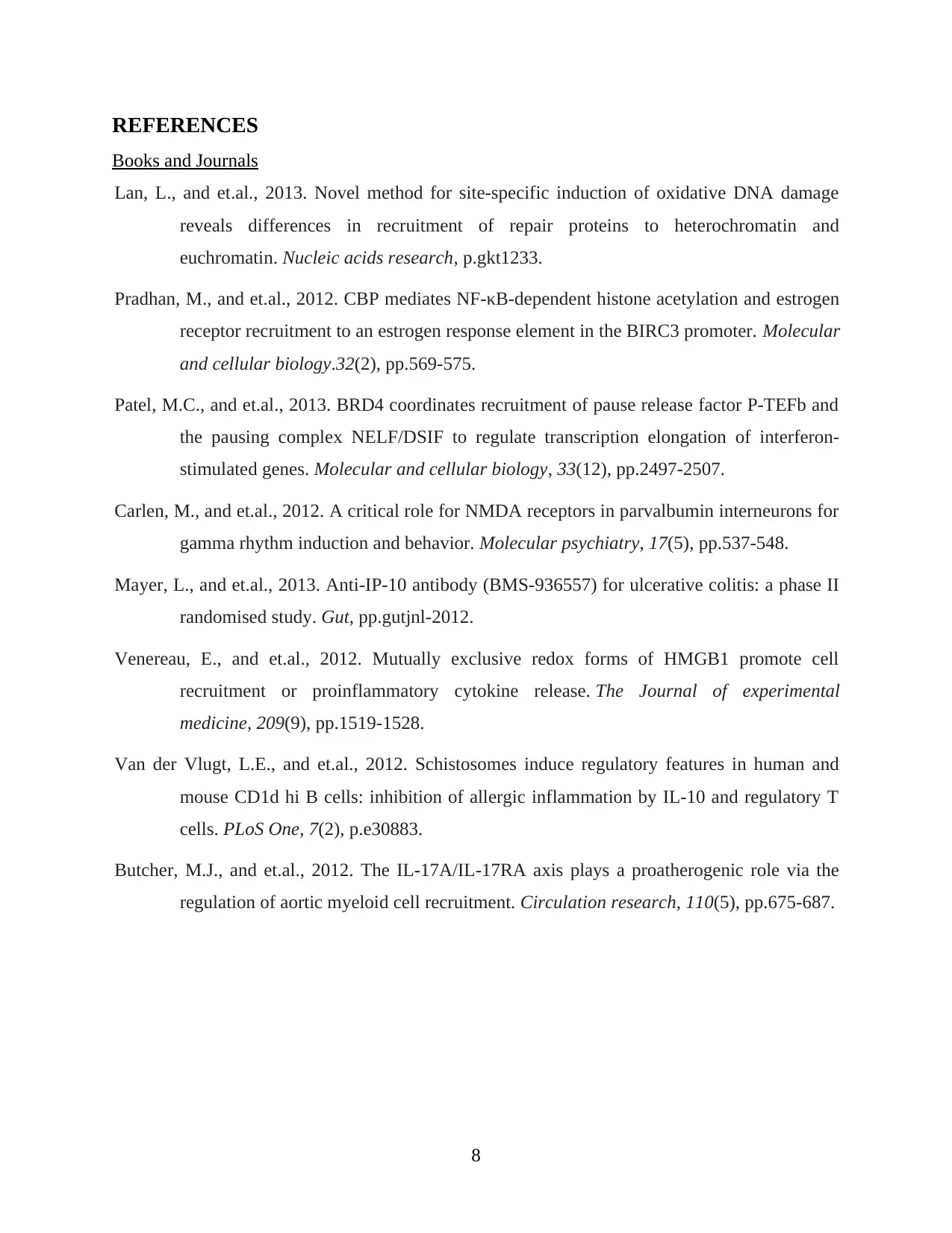
REFERENCES
Books and Journals
Lan, L., and et.al., 2013. Novel method for site-specific induction of oxidative DNA damage
reveals differences in recruitment of repair proteins to heterochromatin and
euchromatin. Nucleic acids research, p.gkt1233.
Pradhan, M., and et.al., 2012. CBP mediates NF-κB-dependent histone acetylation and estrogen
receptor recruitment to an estrogen response element in the BIRC3 promoter. Molecular
and cellular biology.32(2), pp.569-575.
Patel, M.C., and et.al., 2013. BRD4 coordinates recruitment of pause release factor P-TEFb and
the pausing complex NELF/DSIF to regulate transcription elongation of interferon-
stimulated genes. Molecular and cellular biology, 33(12), pp.2497-2507.
Carlen, M., and et.al., 2012. A critical role for NMDA receptors in parvalbumin interneurons for
gamma rhythm induction and behavior. Molecular psychiatry, 17(5), pp.537-548.
Mayer, L., and et.al., 2013. Anti-IP-10 antibody (BMS-936557) for ulcerative colitis: a phase II
randomised study. Gut, pp.gutjnl-2012.
Venereau, E., and et.al., 2012. Mutually exclusive redox forms of HMGB1 promote cell
recruitment or proinflammatory cytokine release. The Journal of experimental
medicine, 209(9), pp.1519-1528.
Van der Vlugt, L.E., and et.al., 2012. Schistosomes induce regulatory features in human and
mouse CD1d hi B cells: inhibition of allergic inflammation by IL-10 and regulatory T
cells. PLoS One, 7(2), p.e30883.
Butcher, M.J., and et.al., 2012. The IL-17A/IL-17RA axis plays a proatherogenic role via the
regulation of aortic myeloid cell recruitment. Circulation research, 110(5), pp.675-687.
8
Books and Journals
Lan, L., and et.al., 2013. Novel method for site-specific induction of oxidative DNA damage
reveals differences in recruitment of repair proteins to heterochromatin and
euchromatin. Nucleic acids research, p.gkt1233.
Pradhan, M., and et.al., 2012. CBP mediates NF-κB-dependent histone acetylation and estrogen
receptor recruitment to an estrogen response element in the BIRC3 promoter. Molecular
and cellular biology.32(2), pp.569-575.
Patel, M.C., and et.al., 2013. BRD4 coordinates recruitment of pause release factor P-TEFb and
the pausing complex NELF/DSIF to regulate transcription elongation of interferon-
stimulated genes. Molecular and cellular biology, 33(12), pp.2497-2507.
Carlen, M., and et.al., 2012. A critical role for NMDA receptors in parvalbumin interneurons for
gamma rhythm induction and behavior. Molecular psychiatry, 17(5), pp.537-548.
Mayer, L., and et.al., 2013. Anti-IP-10 antibody (BMS-936557) for ulcerative colitis: a phase II
randomised study. Gut, pp.gutjnl-2012.
Venereau, E., and et.al., 2012. Mutually exclusive redox forms of HMGB1 promote cell
recruitment or proinflammatory cytokine release. The Journal of experimental
medicine, 209(9), pp.1519-1528.
Van der Vlugt, L.E., and et.al., 2012. Schistosomes induce regulatory features in human and
mouse CD1d hi B cells: inhibition of allergic inflammation by IL-10 and regulatory T
cells. PLoS One, 7(2), p.e30883.
Butcher, M.J., and et.al., 2012. The IL-17A/IL-17RA axis plays a proatherogenic role via the
regulation of aortic myeloid cell recruitment. Circulation research, 110(5), pp.675-687.
8
1 out of 10
Related Documents
Your All-in-One AI-Powered Toolkit for Academic Success.
+13062052269
info@desklib.com
Available 24*7 on WhatsApp / Email
![[object Object]](/_next/static/media/star-bottom.7253800d.svg)
Unlock your academic potential
Copyright © 2020–2025 A2Z Services. All Rights Reserved. Developed and managed by ZUCOL.




